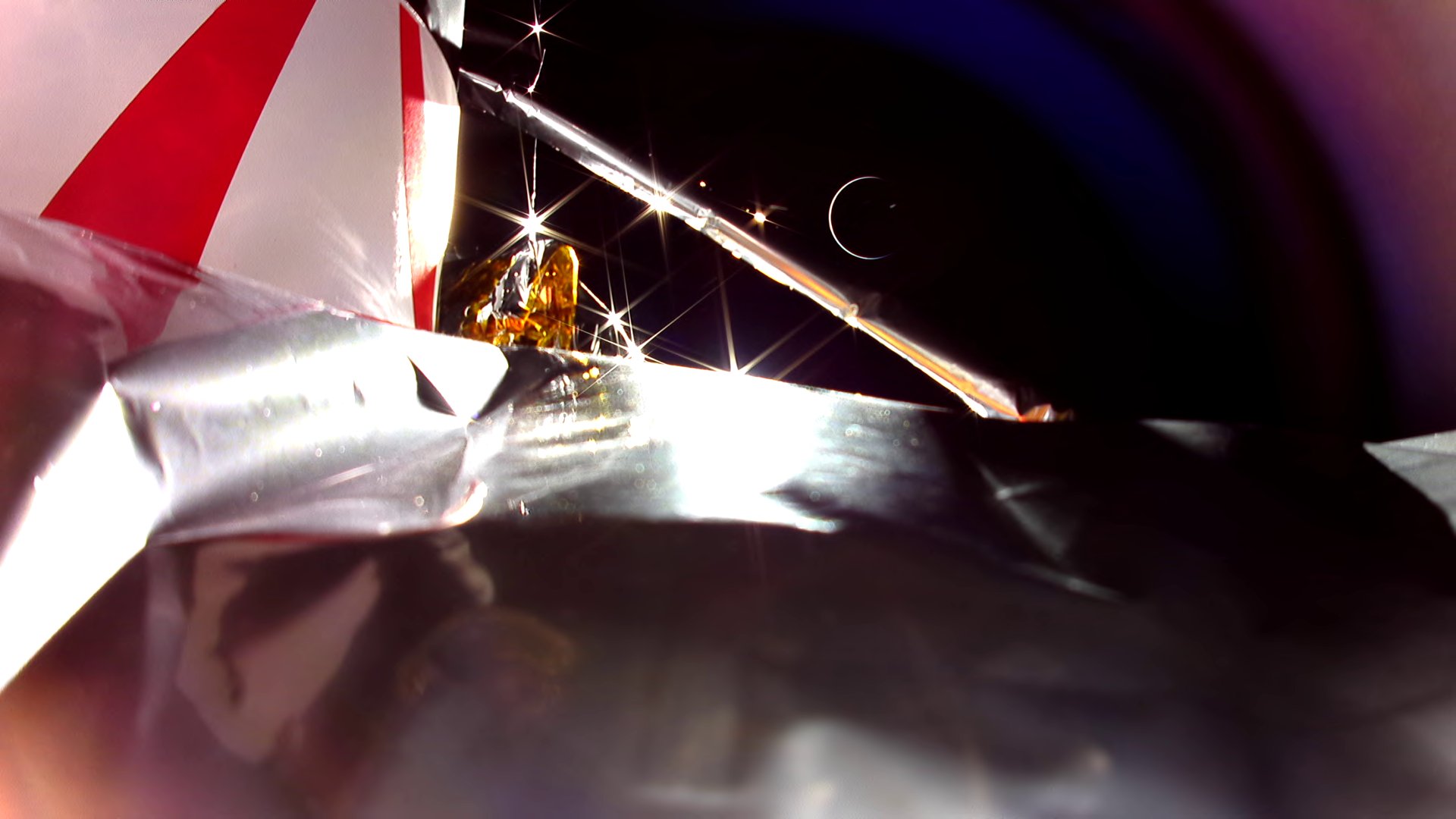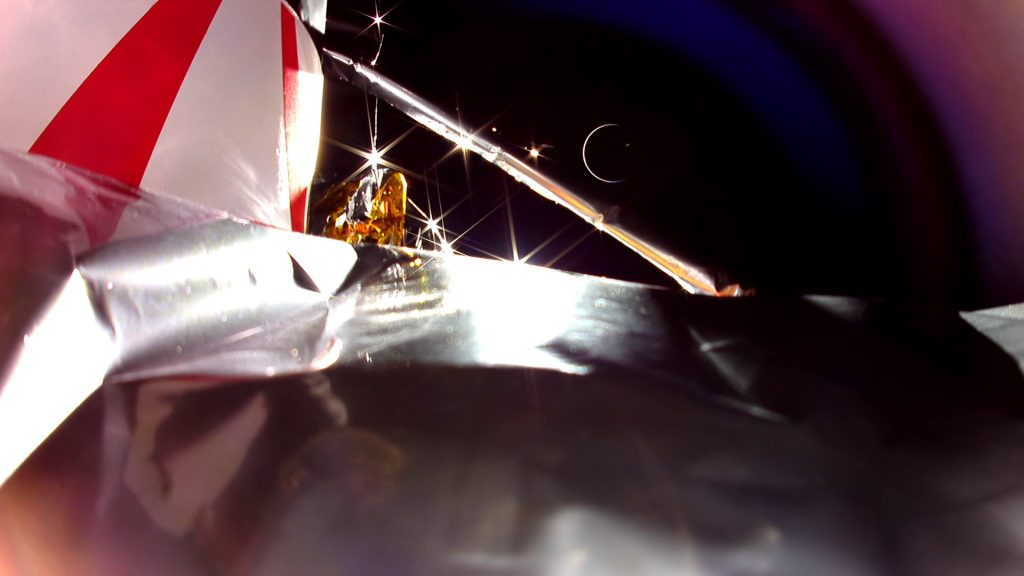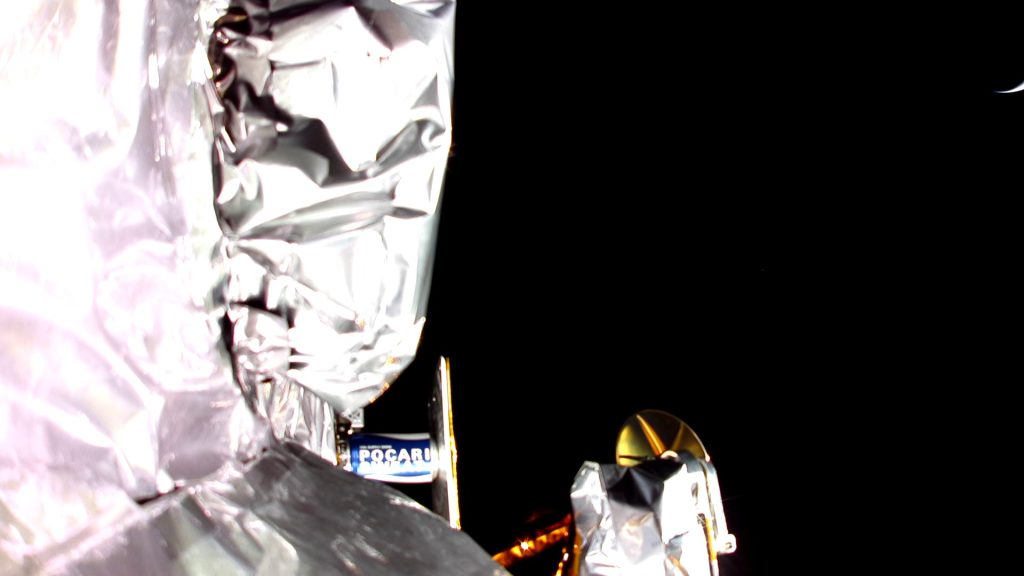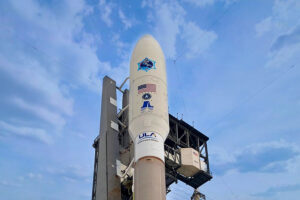Peregrine Updates: Astrobotic’s Moon Mission Ends with a Splash in the South Pacific
8th Jan 2024
Update: 19th January
The Peregrine moon lander returned to Earth over the Pacific Ocean in a fiery end to its ill-fated mission. The lander sent a photo of a crescent Earth as it approached. Photo courtesy of Astrobotic.

Ten days after taking off, Astrobotic’s Peregrine lunar lander fell back to Earth today. Unfortunately, the mission, which aimed to reach the moon’s orbital distance and back, faced a critical setback due to a propellant leak.
An update shared on X / Twitter reported a loss of contact with the spacecraft at approximately 12:50 p.m. PT, aligning with the predicted re-entry time of 1:04 p.m.
Astrobotic also reminisced about the mission, posting a video captured moments after the spacecraft’s separation last week, showcasing Earth as a captivating backdrop.
Update: 18th January
Astrobotic announced that they have maneuvered Peregrine to re-enter Earth’s atmosphere on 18th January at about 2100 GMT. The reentry point should be over the southern Pacific Ocean between New Caledonia and Fiji.
Update: 17th January
Astrobotic is discussing Peregrine’s re-entry with the U.S. government. The ill-fated lunar lander has been in operation for nine days, despite initial estimates of fuel lasting for only 40 hours of operation. The lander did make it to the distance of the Moon’s orbit before heading back Earthward. At the time of posting on X, Astrobotic noted that Peregrine was 183,000 miles from Earth.
Peregrine moon lander lifted off early 8th January on the first-ever mission of United Launch Alliance’s new Vulcan Centaur rocket. The significant liftoff was successful, but Peregrine faced issues soon after separating from the rocket’s Centaur upper stage.
Check out all of the latest news and updates about Astrobotic’s Peregrine journey to the Moon.
Update2: 10th January
Astrobotic announced on X that Peregrine was 80% of the way to lunar orbit. After that, the lander was scheduled to return toward Earth, then back out for its encounter with the Moon. How far along this course Peregrine will go is undetermined currently, as the company’s engineers continue to improve performance. On 9th January, the remaining fuel was calculated as being sufficient for 40 hours of operation. On the 10th, it’s down to 35.
Update1: 10th January
Astrobotic just revealed a new snapshot of Peregrine’s journey. This image continues to fuel curiosity with a possible Earth sighting in the upper right corner. Positioned strategically on a payload deck, the camera grants a unique glimpse of the spacecraft’s intriguing cargo.

Propulsion Anomaly Insights
Also, Astrobotic shares an initial hypothesis regarding Peregrine’s propulsion anomaly. The team suspects a valve issue between the helium pressurant and the oxidizer. This anomaly caused a surge of high-pressure helium, elevating oxidizer tank pressure beyond safe limits and leading to tank rupture.
Update2: 9th January
The Astrobotic team is collecting as much data as possible while the craft is operational. Another positioning event occurred earlier on the 9th, and the team managed to put Peregrine back into position to be able to recharge its batteries.
Update1: 9th January
In a recent statement on X (Twitter), Astrobotic confirms there’s no chance of a soft and safe landing on the Moon. The company added they expect to run out of damaged propellant in about 40 hours. Still, the Astrobotic team keeps trying to figure out a way to expand Peregrine’s operational life.
Astrobotic received the first image from Peregrine Lander. The image shows Multi-Layer Insulation (MLI), Peregrine’s manufacturer Astrobotic said on X (Twitter). The company added that the spacecraft’s battery is fully charged and all efforts are now focused on Peregrine’s existing power to perform as many payload and spacecraft operations as possible.
Previously, we reported that the lander failed to orient itself properly to face the sun to charge its solar panels, an issue that Astrobotic thinks stemmed from an anomaly in Peregrine’s propulsion system. That hypothesis was bolstered by the first image the lander snapped in space.
Now, the company’s primary goal is to get Peregrine as close to the lunar surface as they can, but no hopes for a soft landing.
Update2: 8th January
Astrobotic reports that they have re-established contact with the Peregrine lander after a scheduled blackout period. The ad hoc maneuvre taken just before the blackout has worked as far as charging the batteries is concerned, but the propulsion system is likely to not have enough fuel for a controlled landing on the Moon.
Editor’s note: How Astrobotic’s executives react to what seems now to be an inability to deliver its payloads on the Moon could determine the company’s fate. For a further consideration of how personal reactions can affect space companies in times of difficulty, see the Orbital Today 2023 year in review People and the Space Industry article.
Update1: 8th January
After a successful separation and system check, Astrobotic’s controllers noted that the Peregrine lander is wobbling, and that it’s sensors cannot find the Sun. This lack of orientation affects the ability to charge the lander’s batteries. The company noted that they had tried an alternate method to point the solar panels in the right direction, but a planned blackout period will prevent them from discovering how effective the maneuvre has been.
The company emphasized that more updates are to come.
_…_
Pittsburgh, Pennsylvania based Astrobotic confirms that its Moon lander, Peregrine, has successfully separated from the United Launch Alliance Vulcan and is on its way to the Moon. In a press release, the company stated that it had successfully made contact with the lander about an hour after launch from Florida. Telemetry is being received.
“Today Peregrine Mission One achieved a number of big milestones,” said John Thornton, CEO of Astrobotic. “Peregrine powered on, acquired a signal with Earth, and is now moving through space on its way to the Moon. These successes bring us one step closer to seven nations landing on the Moon, six of which have never been to the Moon before.”
What’s next for Peregrine
Astrobotics confirms that all of the “Stage 2” tasks had been completed, and it’s “Next stop, the Moon!” for Peregrine.
How much does it cost to deliver something to the Moon?
Astrobotic is advertising per kilogram rates for both lunar orbit and lunar landing delivery. If they succeed this time, then the costs might seem well worth it. Currently, Astrobotic is asking:
- $1.2 million per kilogram for a lunar landing delivery
- $300,000 per kilogram to lunar orbit
A Peregrine can carry up to 120kg of payload to the Moon. Astrobotic have plans to create what they call a “medium class” delivery system, called Griffin, which will be able to deliver up to 625kg to the Moon for the same rate per kilogram as a Peregrine. NASA has already selected the Griffin to deliver its VIPER water-hunting rover to the lunar south pole.
![Beauty of the Pink Moon And Lyrid Meteor Shower in This Week’s Best Astrophotos [19-26 April] Beauty of the Pink Moon And Lyrid Meteor Shower in This Week’s Best Astrophotos [19-26 April]](https://orbitaltoday.com/wp-content/uploads/2024/04/Pink-Moon-is-on-its-way-above-the-mountains-1-300x300.jpg)





Thank you for your comment! It will be visible on the site after moderation.